Study on the Impact of Lithium Slag as an Alternative to Washed Sand on Mortar Properties
Abstract
1. Introduction
2. Experimental Investigation
2.1. Raw Materials
2.2. Mix Proportions
2.3. Sample Preparation
2.4. Test Procedures
2.4.1. Fluidity Test
2.4.2. Compressive and Flexural Strength Test
2.4.3. Scanning Electron Microscope (SEM) Test
2.4.4. X-Ray Diffraction (XRD) Test
2.4.5. Pore Structures
2.4.6. Chloride Ion Permeability Resistance Test
3. Experimental Results and Discussion
3.1. Workability
3.2. Mechanical Properties
3.3. Microstructure Analysis
3.4. Hydration Products
3.5. Air Content Properties
3.6. Chloride Ion Permeability Resistance
4. Conclusions
- (1)
- Due to the fine particle size and high water absorption capacity of LS, an increase in its admixture led to a gradual decrease in the fluidity of the mortar. Specifically, the fluidity of SR40 was reduced by 39.29% compared to SR0.
- (2)
- The addition of LS first enhanced and then diminished the compressive and flexural strengths of the mortar. The initial strength enhancement is attributed to the filling effect of LS, while the subsequent decrease is caused by its inferior supporting capability compared to fine aggregates. Furthermore, the 3 d and 28 d compressive strengths of SR40 were reduced by 19.17% and 7.74%, respectively, compared to SR0.
- (3)
- Microstructure, pore characteristics, and chloride ion permeability test results suggest that a 20% substitution rate of LS significantly optimizes the pore structure of the mortar, leading to a reduction in the chloride ion permeability coefficient. Consequently, a 20% substitution rate of LS is recommended as the optimal replacement for fine aggregates.
- (4)
- Further research is recommended to fully understand the impact of LS as a sand substitute on the durability of mortar. It can be speculated that the optimized pore structure resulting from the incorporation of lithium slag will positively influence the durability of mortar.
Author Contributions
Funding
Institutional Review Board Statement
Informed Consent Statement
Data Availability Statement
Conflicts of Interest
References
- Liu, Z.; Wang, J.X.; Jiang, Q.K.; Cheng, G.D.; Li, L.; Kang, Y.X.; Wang, D.M. A green route to sustainable alkali-activated materials by heat and chemical activation of lithium slag. J. Clean. Prod. 2019, 225, 1184–1193. [Google Scholar] [CrossRef]
- He, Z.H.; Du, S.G.; Chen, D. Microstructure of ultra high performance concrete containing lithium slag. J. Hazard. Mater. 2018, 353, 35–43. [Google Scholar] [CrossRef]
- He, Y.; Chen, Q.S.; Qi, C.C.; Zhang, Q.L.; Xiao, C.C. Lithium slag and fly ash-based binder for cemented fine tailings backfill. J Environ. Manag. 2019, 248, 109282. [Google Scholar] [CrossRef]
- Luo, X.F.; Huang, L.; Li, Y.; Chen, Z.J. Preparation of geopolymers from thermally activated lithium slag as sole precursor: Mechanical properties and microstructure. Case Stud. Constr. Mater. 2024, 20, e03248. [Google Scholar] [CrossRef]
- Wang, X.G.; Yu, Y.; Zou, F.B.; Luo, H.Y.; Zhou, Z.H.; Zhu, J.L.; Guo, G.J.; Zhong, Y.W. High performance C-A-S-H seeds from fly ash-carbide slag for activating lithium slag towards a low carbon binder. J. Environ. Manag. 2023, 345, 118658. [Google Scholar] [CrossRef]
- Li, C.B.; Zhang, G.F.; Liu, D.Z.; Wang, M.T. Preparation of lightweight ceramsite from solid waste lithium slag and fly ash. Constr. Build. Mater. 2023, 398, 132419. [Google Scholar] [CrossRef]
- Li, J.Z.; Huang, S.W. Recycling of lithium slag as a green admixture for white reactive powder concrete. J. Mater. Cycles Waste 2020, 22, 1818–1827. [Google Scholar] [CrossRef]
- Wang, J.X.; Han, L.; Liu, Z.; Wang, D.M. Setting controlling of lithium slag-based geopolymer by activator and sodium tetraborate as a retarder and its effects on mortar properties. Cem. Concr. Compos. 2020, 110, 103598. [Google Scholar] [CrossRef]
- Zhou, M.Y.; Yan, J.H.; Fan, J.Y.; Xu, Y.; Lu, Y.W.; Duan, P.; Zhu, Y.C.; Zhang, Z.H.; Lu, Z. Insight to workability, compressive strength and microstructure of lithium slag-steel slag based cement under standard condition. J. Build. Eng. 2023, 75, 107076. [Google Scholar] [CrossRef]
- Gu, X.W.; Wang, H.Y.; Zhu, Z.G.; Liu, J.P.; Xu, X.C.; Wang, Q. Synergistic effect and mechanism of lithium slag on mechanical properties and microstructure of steel slag-cement system. Constr. Build. Mater. 2023, 396, 131768. [Google Scholar] [CrossRef]
- Zhang, L.Q.; Pan, Y.N.; Xu, K.C.; Bi, L.P.; Chen, M.C.; Han, B.G. Corrosion behavior of concrete fabricated with lithium slag as corrosion inhibitor under simulated acid rain corrosion action. J. Clean. Prod. 2022, 377, 134300. [Google Scholar] [CrossRef]
- Al-Fakih, A.; Al-Awsh, W.; Ahmed Al-Koshab, M.Q.; Al-Shugaa, M.A.; Al-Osta, M.A.; Drmosh, Q.A.; Musa, A.E.S.; Abdulqader, M.A.; Elgzoly, M.A.A.; Onaizi, S.A. Effects of zeolitic imidazolate framework-8 nanoparticles on physicomechanical properties and microstructure of limestone calcined clay cement mortar. Constr. Build. Mater. 2023, 366, 130236. [Google Scholar] [CrossRef]
- Zhan, P.M.; Zhang, X.X.; He, Z.H.; Shi, J.Y.; Gencel, O.; Hai Yen, N.T.; Wang, G.C. Strength, microstructure and nanomechanical properties of recycled aggregate concrete containing waste glass powder and steel slag powder. J. Clean. Prod. 2022, 341, 130892. [Google Scholar] [CrossRef]
- Chen, G.; Huang, Y.; Yang, R.; Yu, R.; Xiao, R.; Wang, Z.; Ke, X.; Xie, G.; Cheng, J.; Bao, M. Comparative study on mechanical properties and microstructure development of ultra-high performance concrete incorporating phosphorous slag under different curing regimes. Constr. Build. Mater. 2023, 392, 131963. [Google Scholar] [CrossRef]
- Wang, W.; Wang, J.; Shen, J.; Guo, P. High titanium heavy slag powder as a sustainability filler and its influence on the performance of asphalt mortar. J. Mater. Res. Technol. 2023, 25, 5586–5599. [Google Scholar] [CrossRef]
- Adomako, S.; Engelsen, C.J.; Døssland, L.T.; Danner, T.; Thorstensen, R.T. Technical and environmental properties of recycled aggregates produced from concrete sludge and excavation materials. Case Stud. Constr. Mater. 2023, 19, e02498. [Google Scholar] [CrossRef]
- Ahmad, S.; Upadhyay, S.; Umar, A.; Al-Osta, M.A. Effect of recycled crushed glass and recycled coarse aggregate on the properties of self-compacting concrete. Case Stud. Constr. Mater. 2023, 19, e02532. [Google Scholar] [CrossRef]
- Aliyah, F.; Kambali, I.; Setiawan, A.F.; Radzi, Y.M.; Rahman, A.A. Utilization of steel slag from industrial waste for ionizing radiation shielding concrete: A systematic review. Constr. Build. Mater. 2023, 382, 131360. [Google Scholar] [CrossRef]
- Ozturk, M.; Sevim, U.K.; Akgol, O.; Unal, E.; Karaaslan, M. Investigation of the mechanic, electromagnetic characteristics and shielding effectiveness of concrete with boron ores and boron containing wastes. Constr. Build. Mater. 2020, 252, 119058. [Google Scholar] [CrossRef]
- Santillán, N.; Speranza, S.; Torrents, J.M.; Segura, I. Evaluation of conductive concrete made with steel slag aggregates. Constr. Build. Mater. 2022, 360, 129515. [Google Scholar] [CrossRef]
- Liu, S.H.; Rong, P.J.; Zhang, C.; Lu, J.X.; Guan, X.M.; Shi, C.J.; Zhu, J.P. Preparation and carbonation hardening of low calcium CO2 sequestration materials from waste concrete powder and calcium carbide slag. Cem. Concr. Comp. 2023, 141, 105151. [Google Scholar] [CrossRef]
- Dong, J.L.; Chen, L.W.; Li, L.H.; Zhou, P.; Shi, Z.H.; Cai, J.P.; Zhang, T.T. Investigation into the alkali-activation of lithium slag: A sustainable alternative to conventional cement with optimized mechanical properties. Constr. Build. Mater. 2024, 416, 135022. [Google Scholar] [CrossRef]
- Guo, C.C.; Wang, R. Utilizing lithium slag to improve the physical-chemical properties of alkali-activated metakaolin-slag pastes: Cost and energy analysis. Constr. Build. Mater. 2023, 403, 133164. [Google Scholar] [CrossRef]
- Javed, U.; Shaikh, F.U.A.; Sarker, P.K. Microstructural investigation of lithium slag geopolymer pastes containing silica fume and fly ash as additive chemical modifiers. Cem. Concr. Comp. 2022, 134, 104736. [Google Scholar] [CrossRef]
- Zhang, T.; Ma, B.G.; Tan, H.B.; Liu, X.H.; Chen, P.; Luo, Z.T. Effect of TIPA on mechanical properties and hydration properties of cement-lithium slag system. J. Environ. Manag. 2020, 276, 111274. [Google Scholar] [CrossRef]
- Zhai, M.Y.; Zhao, J.H.; Wang, D.M.; Wang, Y.R.; Wang, Q.B.a. Hydration properties and kinetic characteristics of blended cement containing lithium slag powder. J. Build. Eng. 2021, 39, 102287. [Google Scholar] [CrossRef]
- He, Y.; Liu, S.H.; Hooton, R.D.; Zhang, X.; He, S. Effects of TEA on rheological property and hydration performance of lithium slag-cement composite binder. Constr. Build. Mater. 2022, 318, 125757. [Google Scholar] [CrossRef]
- Amin, M.T.E.; Sarker, P.K.; Shaikh, F.U.A. Transport properties of concrete containing lithium slag. Constr. Build. Mater. 2024, 416, 135073. [Google Scholar] [CrossRef]
- Zhang, Y.N.; Yang, B.H.; Gu, X.W.; Han, D.; Wang, Q.J. Improving the performance of ultra-high performance concrete containing lithium slag by incorporating limestone powder. J. Build. Eng. 2023, 72, 106610. [Google Scholar] [CrossRef]
- Rahman, S.A.; Dodd, A.; Khair, S.; Shaikh, F.U.A.; Sarker, P.K.; Hosan, A. Assessment of lithium slag as a supplementary cementitious material: Pozzolanic activity and microstructure development. Cem. Concr. Comp. 2023, 143, 105262. [Google Scholar] [CrossRef]
- Zhu, Z.G.; Gu, X.W.; Wang, S.Y.; Xu, X.C.; Wang, H.Y.; Liu, J.P.; Zhan, K. Investigation of synergistic effects of lithium slag and granulated blast furnace slag from the perspectives of physics and hydration. J. Build. Eng. 2024, 89, 109337. [Google Scholar] [CrossRef]
- Dong, S.K.; Tu, S.W.; Chen, L.L.; Chen, L.L.; Wu, F.F.; Xie, L.L.; Zhuo, Q.; Yu, S.H. Investigation of the performance of cement mortar incorporating lithium slag as a super-fine aggregate. Front. Mater. 2023, 10, 129979. [Google Scholar] [CrossRef]
- Luo, Q.; Wang, Y.S.; Hong, S.X.; Xing, F.; Dong, B.Q. Properties and microstructure of lithium-slag-based geopolymer by one-part mixing method, Constr. Build. Mater. 2021, 273, 121723. [Google Scholar] [CrossRef]
- GB 175-2023; Common Portland Cement. China Standards Press: Beijing, China, 2023.
- GB/T 2419-2005; Test Method for Fluidity of Cement Mortar. China Standards Press: Beijing, China, 2005.
- GB/T 17671-2021; Test Method of Cement Mortar Strength (ISO Method). China Standards Press: Beijing, China, 2021.
- GB/T 50082-2009; Standard for Test Methods of Long-Term Performance and Durability of Ordinary Concrete. China Standards Press: Beijing, China, 2009.
- Zhang, S.; Ding, J.W.; Liu, J.Y.; Gao, M.Y.; Xue, C.R. Al2O3/SO3 molar ratio of PG-CAC-based binders on the macro-micro properties of cement-treated waste dredged clay. Constr. Build. Mater. 2024, 424, 135950. [Google Scholar] [CrossRef]
- Wang, Y.L.; He, H.; He, F.X. Effect of slaked lime and aluminum sulfate on the properties of dry-mixed masonry mortar. Constr. Build. Mater. 2018, 180, 117–123. [Google Scholar] [CrossRef]
- Liang, S.M.; Liu, Y.H.; Song, G.F.; Yan, H.; Song, B.C.; Liu, J.K. Effect of sulfoaluminate expansive additive on mechanical properties, internal relative humidity, and shrinkage of early-age mortar. Case Stud. Constr. Mater. 2023, 19, e02226. [Google Scholar] [CrossRef]
- Snehal, K.; Das, B.B.; Barbhuiya, S. Synergistic effect of nano silica on carbonation resistance of multi-blended cementitious mortar. Cem. Concr. Comp. 2023, 141, 105125. [Google Scholar] [CrossRef]
- Alwaeli, M.; Gołaszewski, J.; Niesler, M.; Pizoń, J.; Gołaszewska, M. Recycle option for metallurgical sludge waste as a partial replacement for natural sand in mortars containing CSA cement to save the environment and natural resources. J. Hazard. Mater. 2020, 398, 123101. [Google Scholar] [CrossRef]
- Jiang, Y.; Li, B.; Liu, S.; He, J.; Hernandez, A.G. Role of recycled concrete powder as sand replacement in the properties of cement mortar. J. Clean. Prod. 2022, 371, 133424. [Google Scholar] [CrossRef]
- Darvish, P.; Johnson Alengaram, U.; Soon Poh, Y.; Ibrahim, S.; Yusoff, S. Performance evaluation of palm oil clinker sand as replacement for conventional sand in geopolymer mortar. Constr. Build. Mater. 2020, 258, 120352. [Google Scholar] [CrossRef]
- Lu, L.; Yang, Z.X.; Lin, Y.; Dong, S.L. Partial replacement of manufactured sand with homologous granite powder in mortar: The effect on porosity and capillary water absorption. Constr. Build. Mater. 2023, 376, 131031. [Google Scholar] [CrossRef]
- Sharma, R.; Das, K.K.; Pei, J.J.; Jang, J.G. Influence of sillimanite sand and corundum sand on the mechanical property, durability and pore structure of cement mortar. J. Build. Eng. 2023, 80, 108091. [Google Scholar] [CrossRef]
- Hemkemeier, T.A.; Almeida, F.C.R.; Sales, A.; Klemm, A.J. Repair mortars with water treatment plant sludge (WTPS) and sugarcane bagasse ash sand (SBAS) for more eco-efficient and durable constructions. J. Clean. Prod. 2023, 386, 135750. [Google Scholar] [CrossRef]
- Zhao, Z.F.; Xiao, J.Z.; Duan, Z.H.; Hubert, J.; Grigoletto, S.; Courard, L. Performance and durability of self-compacting mortar with recycled sand from crushed brick. J. Build. Eng. 2022, 57, 104867. [Google Scholar] [CrossRef]

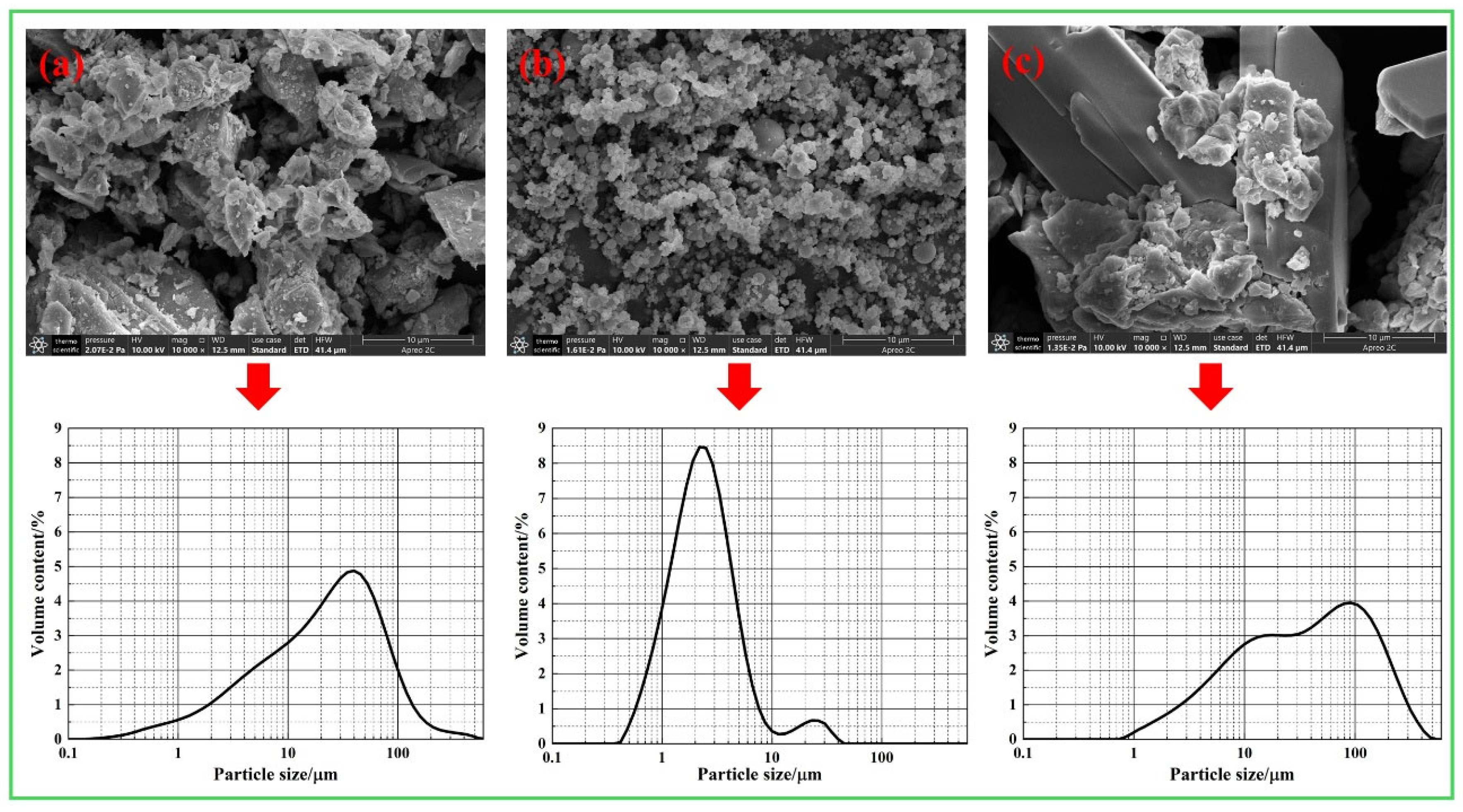

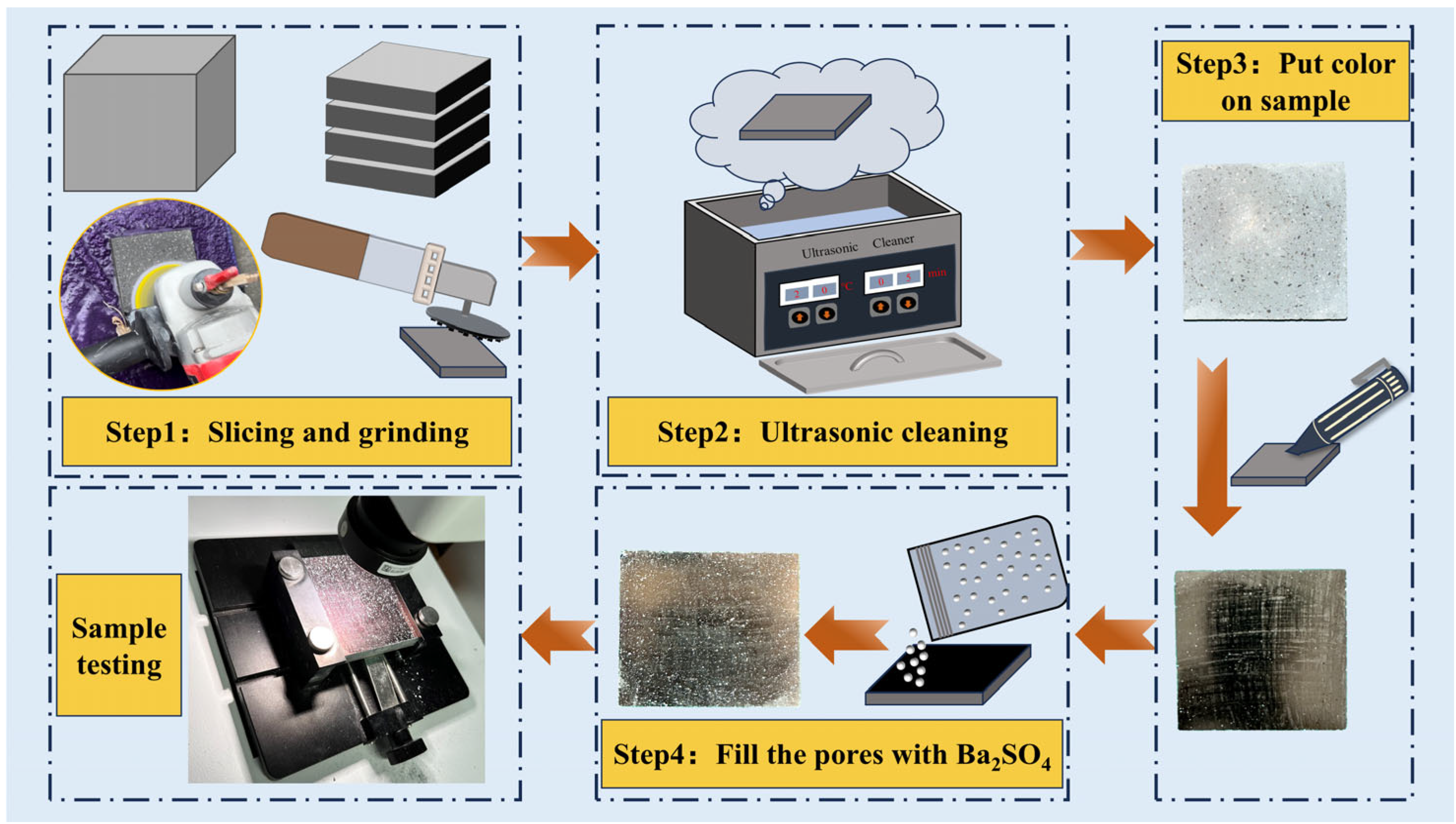
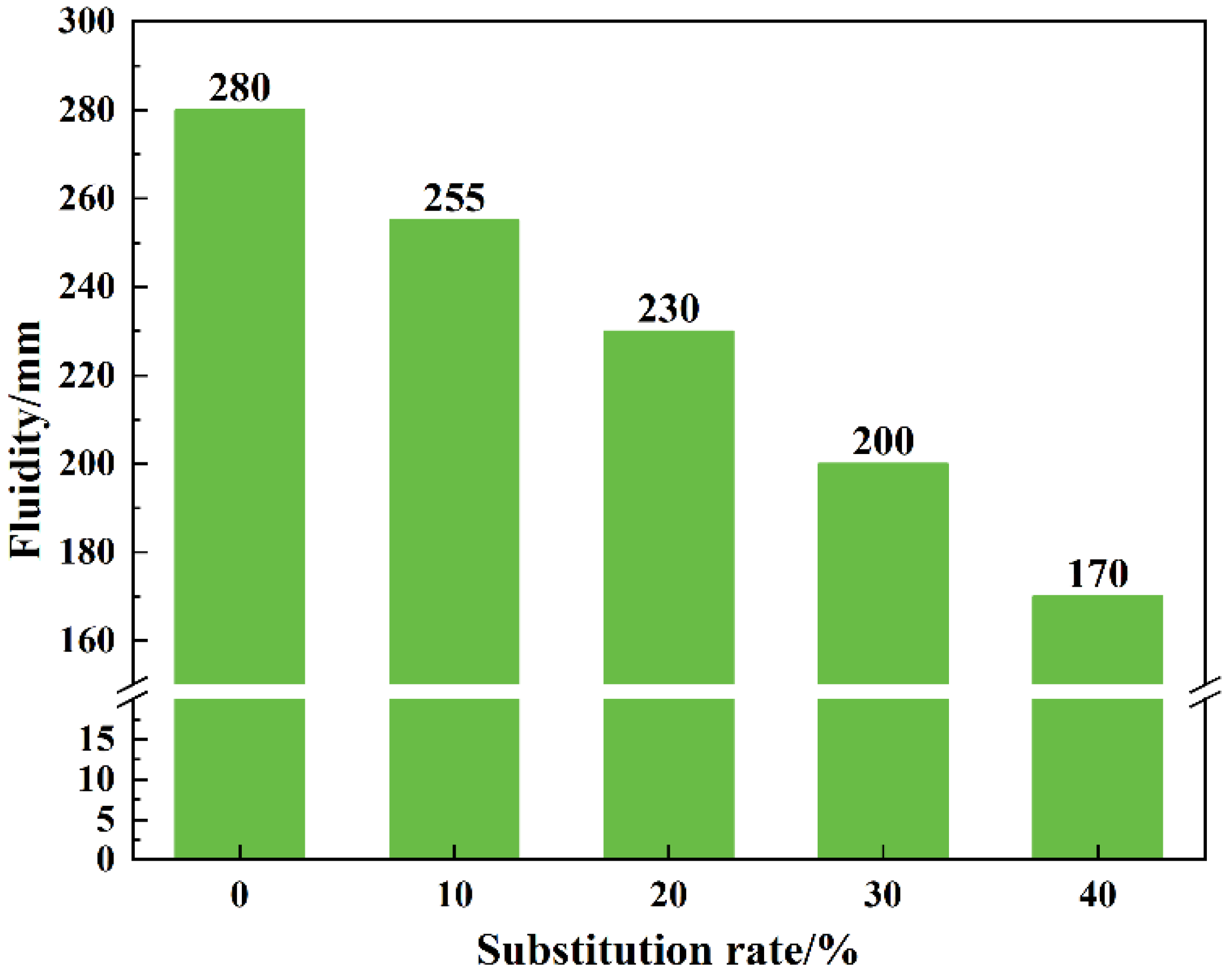
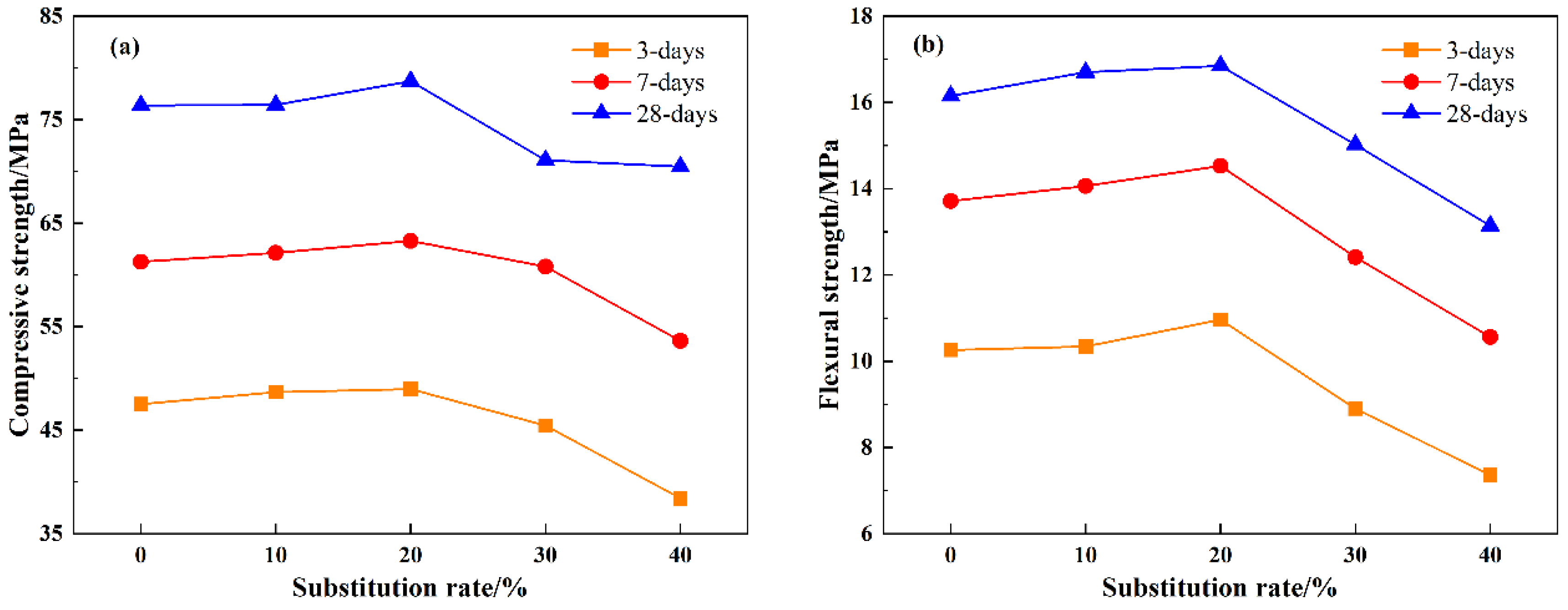
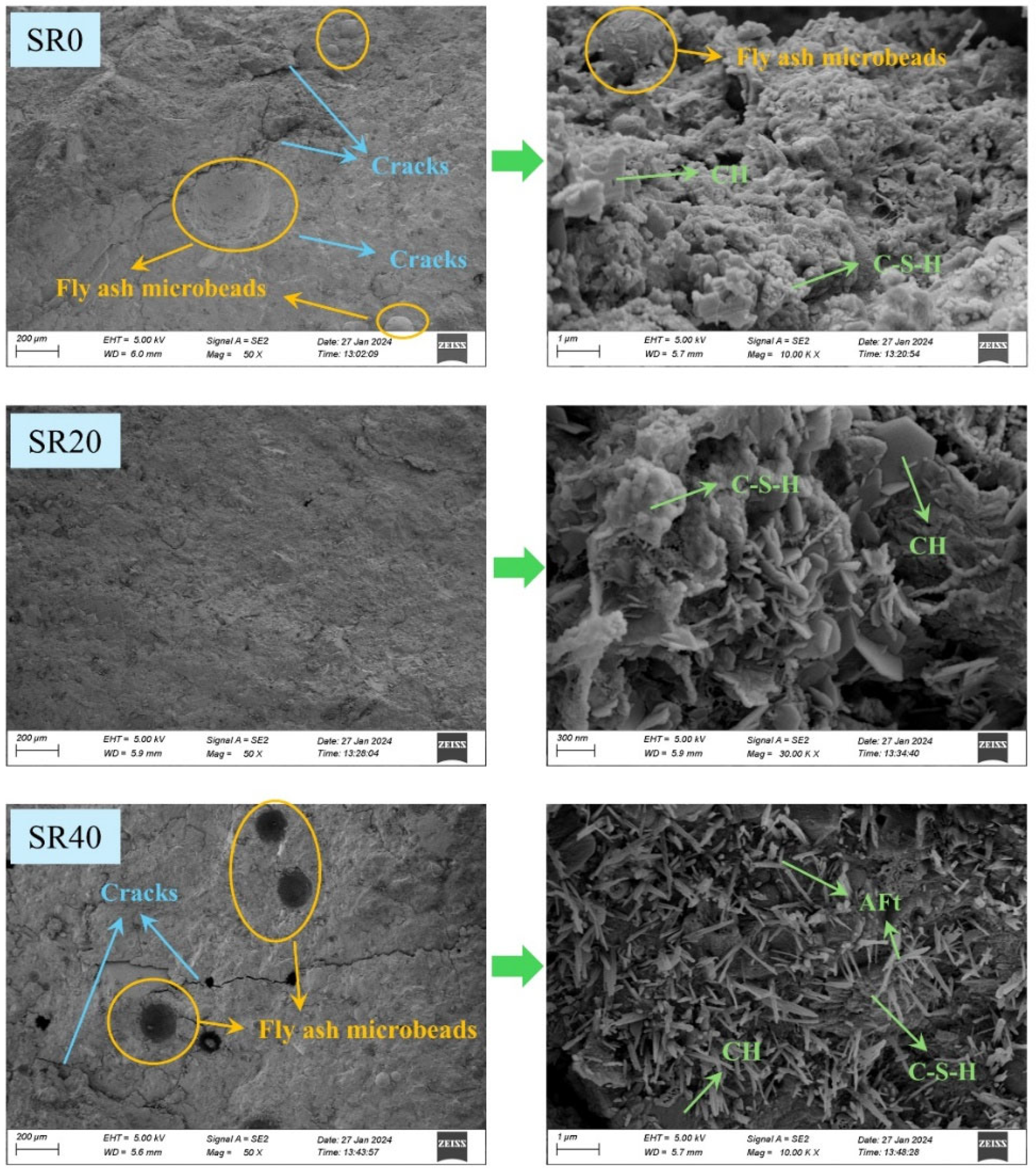

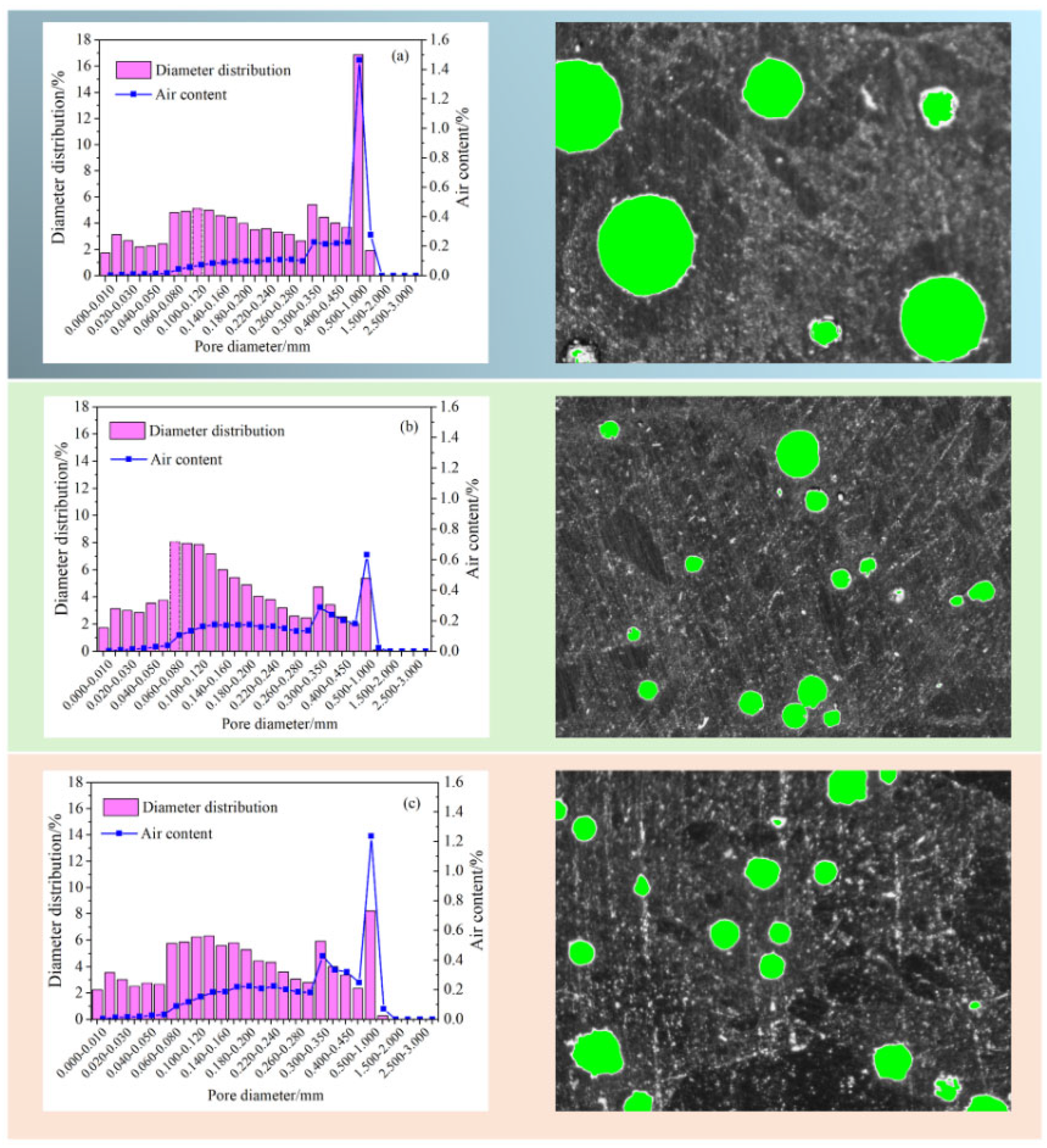
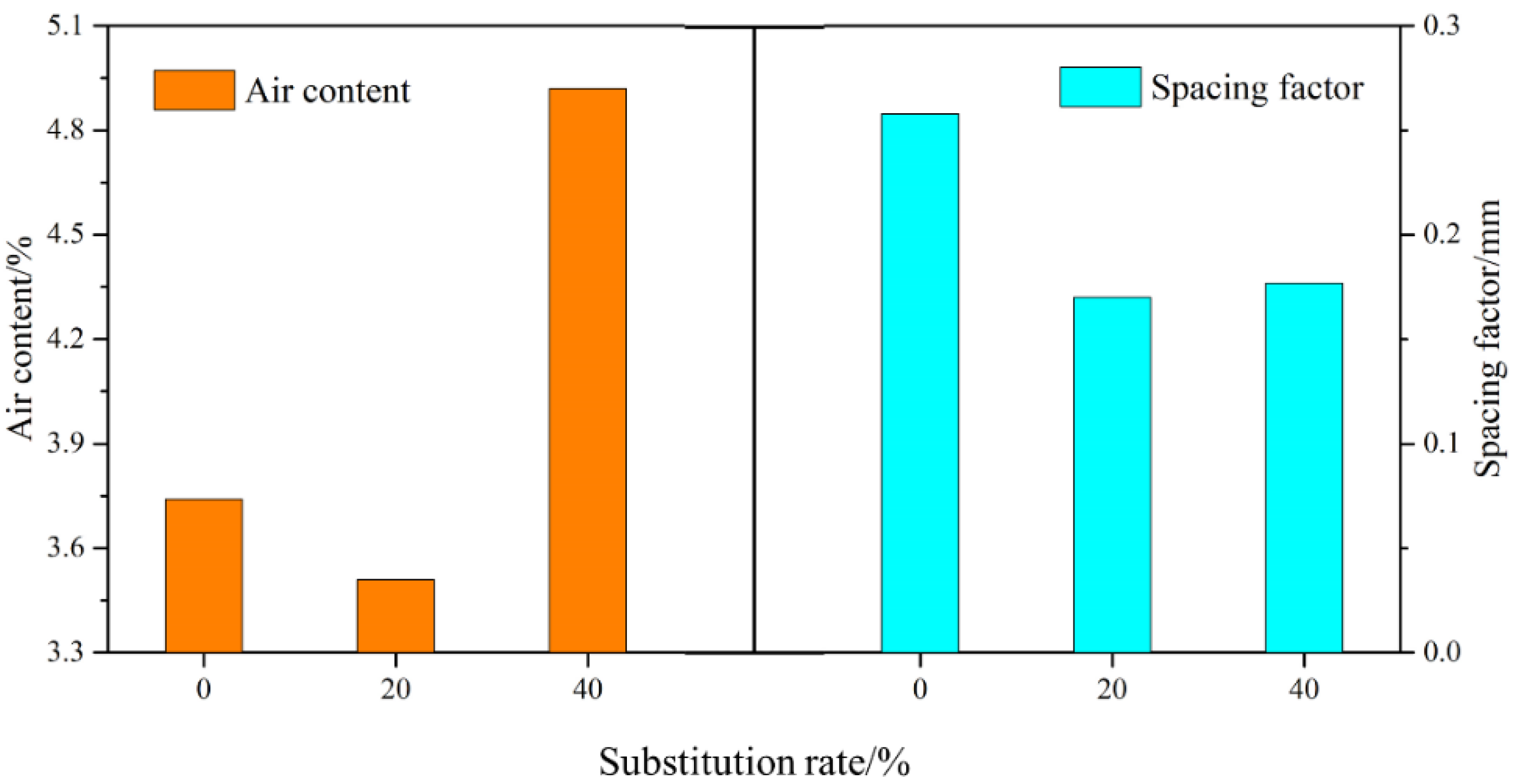
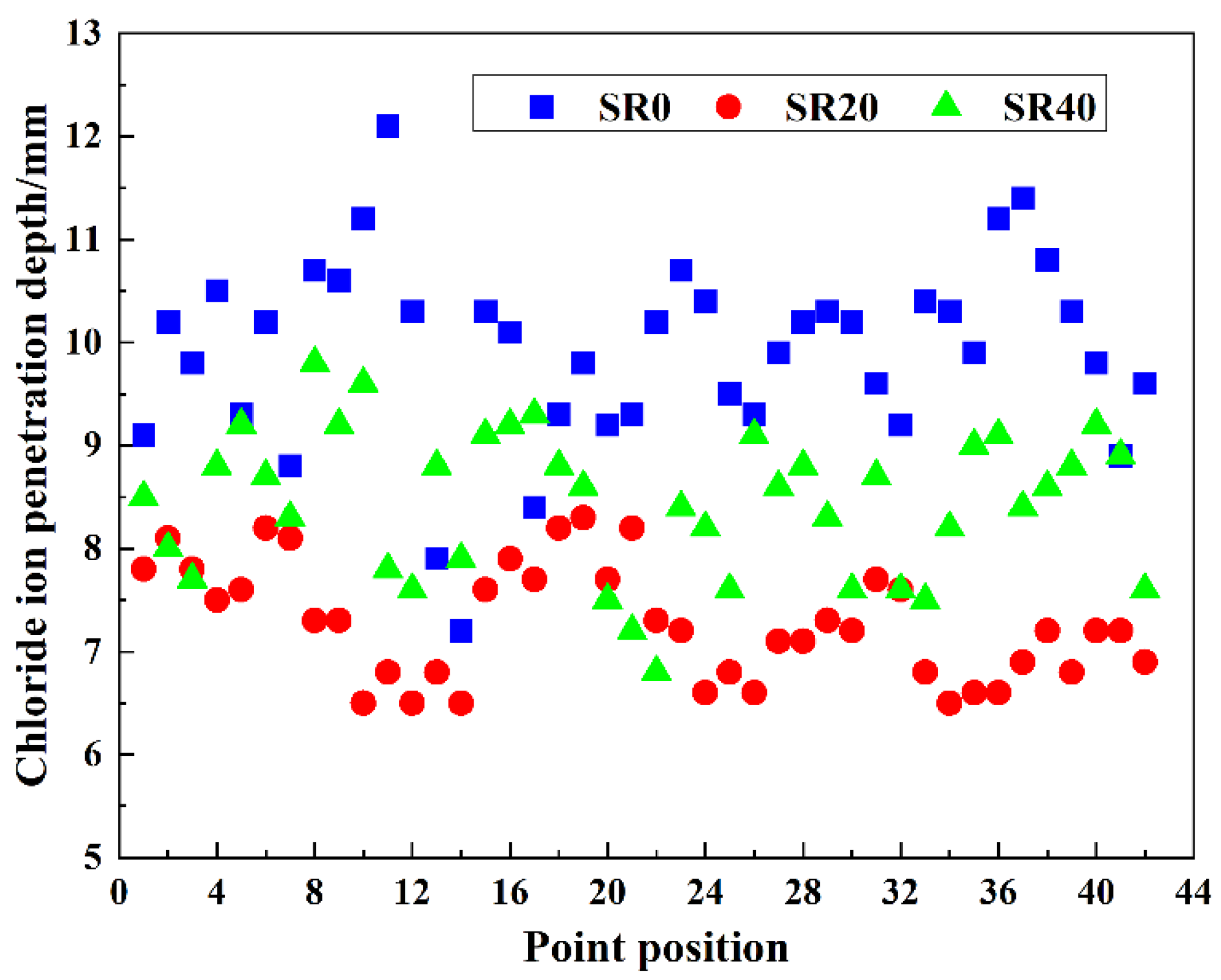
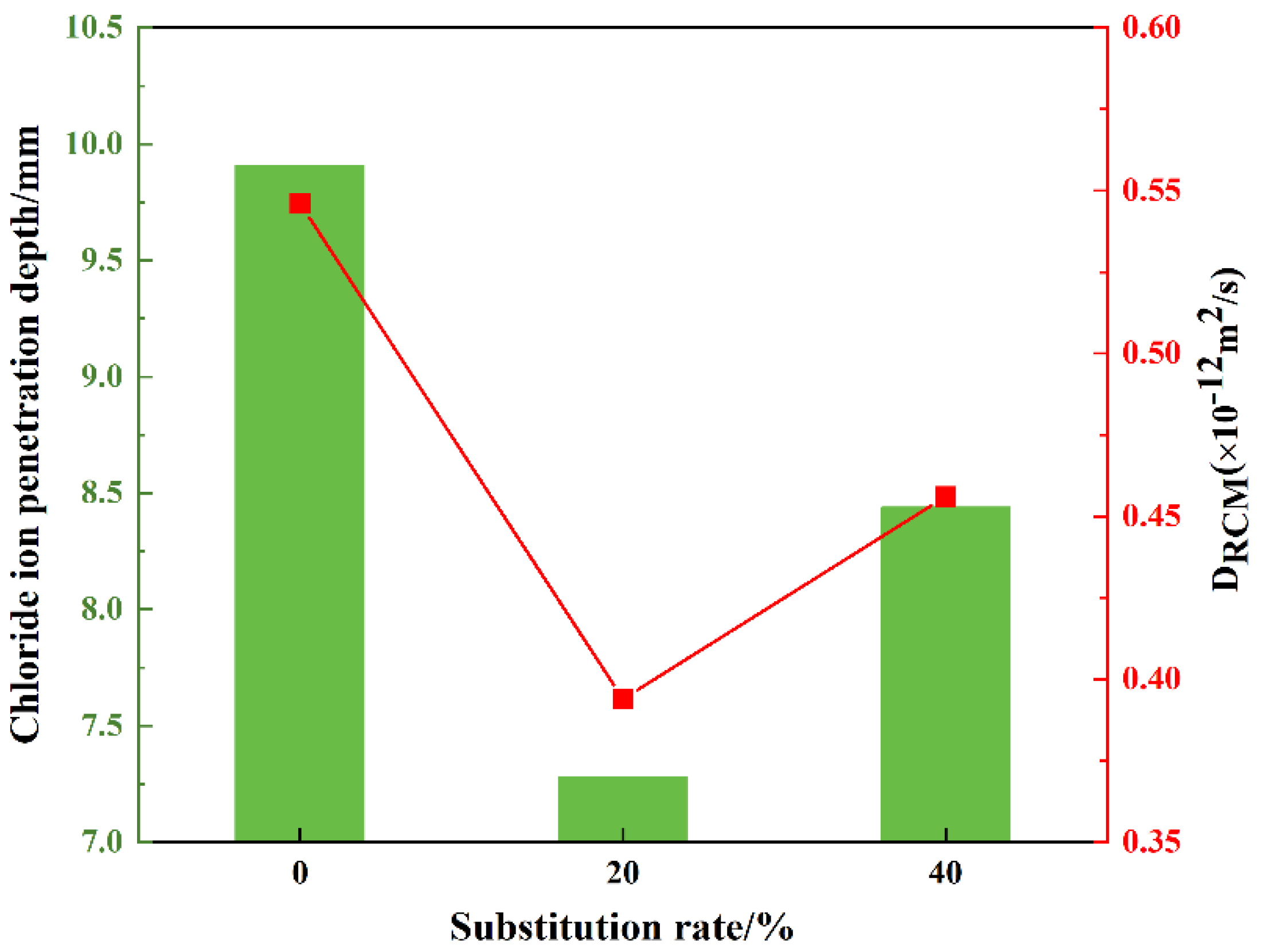
| Materials | Na2O | MgO | Al2O3 | SiO2 | SO3 | K2O | CaO | Fe2O3 | LOI |
|---|---|---|---|---|---|---|---|---|---|
| Cement | 0.27 | 1.51 | 6.85 | 29.22 | 2.41 | 0.18 | 56.32 | 2.88 | 0.36 |
| FA | 2.75 | 0.95 | 14.16 | 53.25 | 2.21 | 2.25 | 9.34 | 7.91 | 7.18 |
| LS | 0.55 | 0.64 | 20.20 | 49.28 | 16.18 | 0.48 | 9.98 | 1.67 | 1.02 |
| Groups | Cement | Fly Ash | Sand | LS | Water | Superplasticizer |
|---|---|---|---|---|---|---|
| SR0 | 630 | 90 | 1134 | 0 | 216 | 2.2 |
| SR10 | 630 | 90 | 1020 | 114 | 216 | 2.4 |
| SR20 | 630 | 90 | 907 | 227 | 216 | 2.8 |
| SR30 | 630 | 90 | 794 | 340 | 216 | 3.2 |
| SR40 | 630 | 90 | 680 | 454 | 216 | 3.6 |
Disclaimer/Publisher’s Note: The statements, opinions and data contained in all publications are solely those of the individual author(s) and contributor(s) and not of MDPI and/or the editor(s). MDPI and/or the editor(s) disclaim responsibility for any injury to people or property resulting from any ideas, methods, instructions or products referred to in the content. |
© 2025 by the authors. Licensee MDPI, Basel, Switzerland. This article is an open access article distributed under the terms and conditions of the Creative Commons Attribution (CC BY) license (https://creativecommons.org/licenses/by/4.0/).
Share and Cite
Zhou, X.; Dai, W.; Zhu, X.; Zhou, X. Study on the Impact of Lithium Slag as an Alternative to Washed Sand on Mortar Properties. Materials 2025, 18, 3490. https://doi.org/10.3390/ma18153490
Zhou X, Dai W, Zhu X, Zhou X. Study on the Impact of Lithium Slag as an Alternative to Washed Sand on Mortar Properties. Materials. 2025; 18(15):3490. https://doi.org/10.3390/ma18153490
Chicago/Turabian StyleZhou, Xianliang, Wei Dai, Xi Zhu, and Xiaojun Zhou. 2025. "Study on the Impact of Lithium Slag as an Alternative to Washed Sand on Mortar Properties" Materials 18, no. 15: 3490. https://doi.org/10.3390/ma18153490
APA StyleZhou, X., Dai, W., Zhu, X., & Zhou, X. (2025). Study on the Impact of Lithium Slag as an Alternative to Washed Sand on Mortar Properties. Materials, 18(15), 3490. https://doi.org/10.3390/ma18153490





